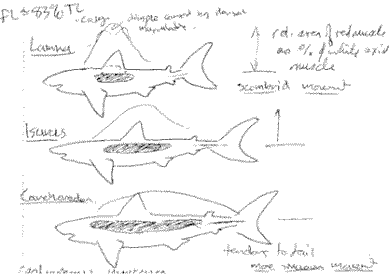Body Shape and Swimming Style
Like other sharks, the Great White is a biological "swimming machine", sculpted by evolution to utilize the properties of water with elegant efficiency. Everything about the White Shark's body shape is stripped-down and fine-tuned to optimize its swimming efficiency in a way that is appropriate for its active lifestyle.
Swimming style and body form are intimately linked. The White Shark combines a solidly-built, torpedo-shaped body, a narrow tail stalk supported by lateral keels, and a crescent moon-shaped caudal fin. This body form — shared by the Great White and its lamnid relatives, the makos and porbeagles — is noticeably different from that of a so-called 'typical' shark and, not surprisingly, these sharks employ a distinctly different swimming style. Unlike the graceful, nearly whole-bodied swimming stroke used by a typical whaler shark (family Carcharhinidae), the lamnids swim in a relatively stiff-bodied, almost 'militaristic' fashion. Each swim stroke involves arching the body laterally into a shallow curve, with the amplitude increasing from very small — at the head and anterior two-thirds of the body — to large — at the posterior edge of the caudal fin. By oscillating the body from side-to-side in this fashion, tremendous swimming speeds can be achieved with remarkable energy economy. This stiff-bodied swimming style is simply the most energy-efficient for a fish with the same general build as a White Shark. Thus, jacks, tunas, billfishes, swordfish, and lamnid sharks have independently evolved a similar body form and swimming style. But this high-speed swimming style comes with a hefty price: significant loss of maneuverability.
|
|
Not all lamnid sharks employ stiff-bodied swimming in precisely the same way. Among lamnids, the very stout-bodied Porbeagle (Lamna nasus) and Salmon Shark (Lamna ditropis) swim the most stiffly, flexing little more than the tail back-and-forth in a rather clunky manner, resembling the motion of a mechanical toy that had been wound up and let go. The sleek Shortfin Mako (Isurus oxyrinchus) swims rather less stiffly, flexing most of the posterior half of its body to generate propulsive strokes. Employing the posterior two-thirds of its body in each propulsive stroke, the moderately stocky White Shark is by far the most graceful swimmer among lamnids. Since the Porbeagle and Salmon Sharks each have a length-to-width ratio closer to 4.5 than any other lamnoid, it is not surprising that they swim in the stiff-bodied style that is close to ideal for their shape. But, if body shape were the only factor that mattered, on the basis of its form, we would predict that the Shortfin Mako — not the White Shark — would employ a swimming stroke that is least stiff-bodied.
Like other sharks, the Great White's swimming muscles are primarily of the type known as "white muscle". But, as with its lamnid relatives and a few other sharks, the White Shark also possess a band of dark "red muscle" that runs along the flanks just under the skin. Red muscle has substantially greater stamina than white. From opportunistic dissections of Porbeagle, Salmon, Shortfin Mako, and White Sharks, I have noted that the length of this band of dark muscle varies considerably among the various genera. Porbeagle and Salmon Sharks (genus Lamna) typically have a very short band of red muscle along their flanks, the Shortfin Mako's (Isurus) are somewhat longer, and those of the White Shark (Carcharodon) longest of all. Given red muscles' stamina, the White Shark's less stiff-bodied swimming style compared with other lamnids may be due to the fact that it has the most extensive band of red muscle along its flanks.
This marriage between muscle form and swimming function may result in significant advantages to the White Shark. If the benefits of stiff-bodied swimming comes at the cost of reduced maneuverability, the development of a more sinuous propulsive stroke may partially off-set that loss. As such, the White Shark may be more maneuverable than its lamnid cousins. This ability, in turn, may lead to predatory advantages when pursuing such swift and agile prey as seals and sea lions. If this is true, the Great White has struck a highly beneficial compromise between the limitations of its body form and the adaptability of its red muscle band.

